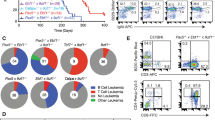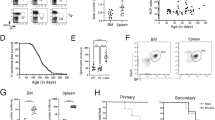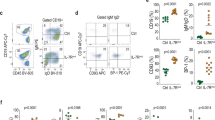Abstract
Understanding the heterogeneous genetic mechanisms of tumor initiation in lymphoid leukemias (LL) will lead to improvements in prognostic classification and treatment regimens. In previous studies of mouse leukemias, we showed that retroviral insertion at the ecotropic viral insertion site 32 locus leads to increased expression of Prdm14, a pluripotency gene implicated in the self-renewal capacity of embryonic stem cells and the early stages of breast cancer. Here, we show that PRDM14 is also overexpressed in ∼25% of human lymphoid neoplasms, with increased frequencies in T-cell acute LL and hyperdiploid precursor B-cell acute LL. To test if Prdm14 overexpression could initiate leukemia, mice were transduced with bone marrow cells transfected with a Prdm14 expression vector. LLs developed in 96% of female mice and 42% of male mice. Before the onset of leukemia, differentiation of transduced cells was biased up to 1000-fold toward cells with features of common lymphoid progenitors (CLPs), and lymphoid differentiation showed a relative block at the pro-B stage. Microarray gene expression analysis of expanded CLP-like cells before the onset of leukemia demonstrated upregulation of genes involved in pluripotency, tumor initiation, early B-lineage commitment, Wnt/Ras signaling and the epithelial-to-mesenchymal transition. Among the dysregulated genes were imprinted genes and non-coding RNAs including Dlk1 and Meg3, which are also key pluripotency mediators. Heightened expression of the estrogen-dependent oncogene, Myb, in tumors suggests a basis for the increased frequency of cancer in female mice. These data provide the first direct evidence for the association of Prdm14 with cancer initiation in an in vivo mouse model and in human lymphoid malignancies, while suggesting mechanisms for Prdm14's mode of action.
This is a preview of subscription content, access via your institution
Access options
Subscribe to this journal
Receive 50 print issues and online access
$259.00 per year
only $5.18 per issue
Buy this article
- Purchase on Springer Link
- Instant access to full article PDF
Prices may be subject to local taxes which are calculated during checkout







Similar content being viewed by others
References
Akagi K, Suzuki T, Stephens RM, Jenkins NA, Copeland NG . (2004). RTCGD: retroviral tagged cancer gene database. Nucleic Acids Res 32: D523–D527.
Baudat F, Buard J, Grey C, Fledel-Alon A, Ober C, Przeworski M et al. (2010). PRDM9 is a major determinant of meiotic recombination hotspots in humans and mice. Science 327: 836–840.
Besmer P, Manova K, Duttlinger R, Huang EJ, Packer A, Gyssler C et al. (1993). The kit-ligand (steel factor) and its receptor c-kit/W: pleiotropic roles in gametogenesis and melanogenesis. Dev Suppl, 125–137.
Bhojwani D, Kang H, Moskowitz NP, Min DJ, Lee H, Potter JW et al. (2006). Biologic pathways associated with relapse in childhood acute lymphoblastic leukemia: a Children's Oncology Group Study. Blood 108: 711–717.
Boles MK, Wilkinson BM, Wilming LG, Liu B, Probst FJ, Harrow J et al. (2009). Discovery of candidate disease genes in ENU-induced mouse mutants by large-scale sequencing, including a splice-site mutation in nucleoredoxin. PLoS Genet 5: e1000759.
Castor A, Nilsson L, Astrand-Grundstrom I, Buitenhuis M, Ramirez C, Anderson K et al. (2005). Distinct patterns of hematopoietic stem cell involvement in acute lymphoblastic leukemia. Nat Med 11: 630–637.
Chia NY, Chan YS, Feng B, Lu X, Orlov YL, Moreau D et al. (2010). A genome-wide RNAi screen reveals determinants of human embryonic stem cell identity. Nature 468: 316–3120.
Davi F, Gocke C, Smith S, Sklar J . (1996). Lymphocytic progenitor cell origin and clonal evolution of human B-lineage acute lymphoblastic leukemia. Blood 88: 609–621.
Davidsson J, Paulsson K, Lindgren D, Lilljebjorn H, Chaplin T, Forestier E et al. (2010). Relapsed childhood high hyperdiploid acute lymphoblastic leukemia: presence of preleukemic ancestral clones and the secondary nature of microdeletions and RTK-RAS mutations. Leukemia 24: 924–931.
Dennis Jr G, Sherman BT, Hosack DA, Yang J, Gao W, Lane HC et al. (2003). DAVID: database for annotation, visualization, and integrated discovery. Genome Biol 4: P3.
Dettman EJ, Justice MJ . (2008). The zinc finger SET domain gene Prdm14 is overexpressed in lymphoblastic lymphomas with retroviral insertions at Evi32. PLoS One 3: e3823.
Downing JR, Mullighan CG . (2006). Tumor-specific genetic lesions and their influence on therapy in pediatric acute lymphoblastic leukemia. Hematology Am Soc Hematol Educ Program 508: 118–122.
Drabsch Y, Hugo H, Zhang R, Dowhan DH, Miao YR, Gewirtz AM et al. (2007). Mechanism of and requirement for estrogen-regulated MYB expression in estrogen-receptor-positive breast cancer cells. Proc Natl Acad Sci USA 104: 13762–13767.
Ford AM, Fasching K, Panzer-Grumayer ER, Koenig M, Haas OA, Greaves MF . (2001). Origins of ‘late’ relapse in childhood acute lymphoblastic leukemia with TEL-AML1 fusion genes. Blood 98: 558–564.
Fredrickson TN, Hartley JW, Morse III HC, Chattopadhyay SK, Lennert K . (1995). Classification of mouse lymphomas. Curr Topics Microbiol Immunol 194: 109–116.
Fumasoni I, Meani N, Rambaldi D, Scafetta G, Alcalay M, Ciccarelli FD . (2007). Family expansion and gene rearrangements contributed to the functional specialization of PRDM genes in vertebrates. BMC Evol Biol 7: 187.
Greig KT, de Graaf CA, Murphy JM, Carpinelli MR, Pang SH, Frampton J et al. (2010). Critical roles for c-Myb in lymphoid priming and early B-cell development. Blood 115: 2796–2805.
Guerin M, Sheng ZM, Andrieu N, Riou G . (1990). Strong association between c-myb and oestrogen-receptor expression in human breast cancer. Oncogene 5: 131–135.
Hansen GM, Skapura D, Justice MJ . (2000). Genetic profile of insertion mutations in mouse leukemias and lymphomas. Genome Res 10: 237–243.
Hao X, Shin MS, Zhou JX, Qi CF, Naghashfar Z et al. (2006). Histologic and molecular characterizations of megakaryocytic leukemia in mice. Leuk Res 30: 397–406.
Hawley RG, Fong AZ, Burns BF, Hawley TS . (1992). Transplantable myeloproliferative disease induced in mice by an interleukin 6 retrovirus. J Exp Med 176: 1149–1163.
Hayashi K, Yoshida K, Matsui Y . (2005). A histone H3 methyltransferase controls epigenetic events required for meiotic prophase. Nature 438: 374–378.
Hennessy BT, Gonzalez-Angulo AM, Stemke-Hale K, Gilcrease MZ, Krishnamurthy S, Lee JS et al. (2009). Characterization of a naturally occurring breast cancer subset enriched in epithelial-to-mesenchymal transition and stem cell characteristics. Cancer Res 69: 4116–4124.
Hu M, Yao J, Cai L, Bachman KE, van den Brule F, Velculescu V et al. (2005). Distinct epigenetic changes in the stromal cells of breast cancers. Nat Genet 37: 899–905.
Huang da W, Sherman BT, Lempicki RA . (2009). Systematic and integrative analysis of large gene lists using DAVID bioinformatics resources. Nat Protoc 4: 44–57.
Jiang GL, Huang S . (2000). The yin-yang of PR-domain family genes in tumorigenesis. Histol Histopathol 15: 109–117.
Jonkers S, Berns A . (1996). Retroviral insertional mutagenesis as a strategy to identify cancer genes. Biochimica et biophysica acta 1287: 29–57.
Jordan CT . (2006). Searching for leukemia stem cells—not yet the end of the road? Cancer Cell 10: 253–254.
Khoury H, Suarez-Saiz F, Wu S, Minden MD . (2010). An upstream insulator regulates DLK1 imprinting in AML. Blood 115: 2260–2263.
Kim KC, Geng L, Huang S . (2003). Inactivation of a histone methyltransferase by mutations in human cancers. Cancer Res 63: 7619–7623.
Kim KC, Huang S . (2003). Histone methyltransferases in tumor suppression. Cancer Biol Ther 2: 491–499.
Kinameri E, Inoue T, Aruga J, Imayoshi I, Kageyama R, Shimogori T et al. (2008). Prdm proto-oncogene transcription factor family expression and interaction with the Notch-Hes pathway in mouse neurogenesis. PLoS ONE 3: e3859.
Ko CD, Kim JS, Ko BG, Son BH, Kang HJ, Yoon HS et al. (2003). The meaning of the c-kit proto-oncogene product in malignant transformation in human mammary epithelium. Clin Exp Metastasis 20: 593–597.
Kondo M, Weissman IL, Akashi K . (1997). Identification of clonogenic common lymphoid progenitors in mouse bone marrow. Cell 91: 661–672.
Kurimoto K, Yamaji M, Seki Y, Saitou M . (2008). Specification of the germ cell lineage in mice: a process orchestrated by the PR-domain proteins, Blimp1 and Prdm14. Cell Cycle 7: 3514–3518.
Liu L, Luo GZ, Yang W, Zhao X, Zheng Q, Lv Z et al. (2010). Activation of the imprinted Dlk1-Dio3 region correlates with pluripotency levels of mouse stem cells. J Biol Chem 285: 19483–19490.
Czerwinski DK, Wechser MA, Levy R . (2003). Optimization of quantitative real-time RT-PCR parameters for the study of lymphoid malignancies. Leukemia 17: 789–795.
Maser RS, Choudhury B, Campbell PJ, Feng B, Wong KK, Protopopov A et al. (2007). Chromosomally unstable mouse tumours have genomic alterations similar to diverse human cancers. Nature 447: 966–971.
Moelans CB, de Weger RA, Monsuur HN, Vijzelaar R, van Diest PJ . (2010). Molecular profiling of invasive breast cancer by multiplex ligation-dependent probe amplification-based copy number analysis of tumor suppressor and oncogenes. Mod Pathol 23: 1029–1039.
Morse III HC, Anver MR, Fredrickson TN, Haines DC, Harris AW, Harris NL et al. (2002). Bethesda proposals for classification of lymphoid neoplasms in mice. Blood 100: 246–258.
Mullighan CG, Flotho C, Downing JR . (2005). Genomic assessment of pediatric acute leukemia. Cancer J (Sudbury, MA) 11: 268–282.
Mullighan CG, Goorha S, Radtke I, Miller CB, Coustan-Smith E, Dalton JD et al. (2007). Genome-wide analysis of genetic alterations in acute lymphoblastic leukaemia. Nature 446: 758–764.
Mullighan CG, Phillips LA, Su X, Ma J, Miller CB, Shurtleff SA et al. (2008). Genomic analysis of the clonal origins of relapsed acute lymphoblastic leukemia. Science 322: 1377–1380.
Mullighan CG, Su X, Zhang J, Radtke I, Phillips LA, Miller CB et al. (2009). Deletion of IKZF1 and prognosis in acute lymphoblastic leukemia. N Engl J Med 360: 470–480.
Myers S, Bowden R, Tumian A, Bontrop RE, Freeman C, MacFie TS et al. (2010). Drive against hotspot motifs in primates implicates the PRDM9 gene in meiotic recombination. Science 327: 876–879.
Costanzi E, Haas M, Verma IM . (1996). The pCL vector system: rapid production of helper-free, high-titer, recombinant retroviruses. J Virol 70: 5701–5705.
Nishikawa N, Toyota M, Suzuki H, Honma T, Fujikane T, Ohmura T et al. (2007). Gene amplification and overexpression of PRDM14 in breast cancers. Cancer Res 67: 9649–9657.
Ohinata Y, Ohta H, Shigeta M, Yamanaka K, Wakayama T, Saitou M . (2009). A signaling principle for the specification of the germ cell lineage in mice. Cell 137: 571–584.
Palmu S, Soderstrom KO, Quazi K, Isola J, Salminen E . (2002). Expression of C-KIT and HER-2 tyrosine kinase receptors in poor-prognosis breast cancer. Anticancer Res 22: 411–414.
Parvanov ED, Petkov PM, Paigen K . (2010). Prdm9 controls activation of mammalian recombination hotspots. Science, 327–835.
Pasqualucci L, Compagno M, Houldsworth J, Monti S, Grunn A, Nandula SV et al. (2006). Inactivation of the PRDM1/BLIMP1 gene in diffuse large B cell lymphoma. J Exp Med 203: 311–317.
Persons DA, Allay JA, Allay ER, Smeyne RJ, Ashmun RA, Sorrentino BP et al. (1997). Retroviral-mediated transfer of the green fluorescent protein gene into murine hematopoietic cells facilitates scoring and selection of transduced progenitors in vitro and identification of genetically modified cells in vivo. Blood 90: 1777–1786.
Pizzo PA, Poplack DG . (2006). Principles and practice of pediatric oncology, 5th edn. Lippincott Williams & Wilkins: Philadelphia.
Ramsay RG, Gonda TJ . (2008). MYB function in normal and cancer cells. Nat Rev 8: 523–534.
Ross ME, Zhou X, Song G, Shurtleff SA, Girtman K, Williams WK et al. (2003). Classification of pediatric acute lymphoblastic leukemia by gene expression profiling. Blood 102: 2951–2959.
Sakajiri S, O'Kelly J, Yin D, Miller CW, Hofmann WK, Oshimi K et al. (2005). Dlk1 in normal and abnormal hematopoiesis. Leukemia 19: 1404–1410.
Sauvageau G, Thorsteinsdottir U, Eaves CJ, Lawrence HJ, Largman C, Lansdorp PM et al. (1995). Overexpression of HOXB4 in hematopoietic cells causes the selective expansion of more primitive populations in vitro and in vivo. Genes Dev 9: 1753–1765.
Singh A, Settleman J . (2010). EMT, cancer stem cells and drug resistance: an emerging axis of evil in the war on cancer. Oncogene 29: 4741–4751.
Sorich MJ, Pottier N, Pei D, Yang W, Kager L, Stocco G et al. (2008). in vivo response to methotrexate forecasts outcome of acute lymphoblastic leukemia and has a distinct gene expression profile. PLoS Med 5: e83.
Stadtfeld M, Apostolou E, Akutsu H, Fukuda A, Follett P, Natesan S et al. (2010). Aberrant silencing of imprinted genes on chromosome 12qF1 in mouse induced pluripotent stem cells. Nature 465: 175–181.
Surani MA, Hayashi K, Hajkova P . (2007). Genetic and epigenetic regulators of pluripotency. Cell 128: 747–762.
Suzuki T, Shen H, Akagi K, Morse HC, Malley JD, Naiman DQ et al. (2002). New genes involved in cancer identified by retroviral tagging. Nat Genet 32: 166–174.
Tremblay M, Tremblay CS, Herblot S, Aplan PD, Hebert J, Perreault C et al. (2010). Modeling T-cell acute lymphoblastic leukemia induced by the SCL and LMO1 oncogenes. Genes Dev 24: 1093–1105.
Tsuda H, Tani Y, Weisenberger J, Kitada S, Hasegawa T, Murata T et al. (2005). Frequent KIT and epidermal growth factor receptor overexpressions in undifferentiated-type breast carcinomas with ′stem-cell-like′ features. Cancer Sci 96: 333–339.
Tsuneyoshi N, Sumi T, Onda H, Nojima H, Nakatsuji N, Suemori H . (2008). PRDM14 suppresses expression of differentiation marker genes in human embryonic stem cells. Biochem Biophys Res Commun 367: 899–905.
Villadsen R, Fridriksdottir AJ, Ronnov-Jessen L, Gudjonsson T, Rank F, LaBarge MA et al. (2007). Evidence for a stem cell hierarchy in the adult human breast. J Cell Biol 177: 87–101.
Weiser KC, Liu B, Hansen GM, Skapura D, Hentges KE, Yarlagadda S et al. (2007). Retroviral insertions in the VISION database identify molecular pathways in mouse lymphoid leukemia and lymphoma. Mamm Genome 18: 709–722.
Yamaji M, Seki Y, Kurimoto K, Yabuta Y, Yuasa M, Shigeta M et al. (2008). Critical function of Prdm14 for the establishment of the germ cell lineage in mice. Nat Genet 40: 1016–1022.
Yan XQ, Lacey D, Hill D, Chen Y, Fletcher F, Hawley RG et al. (1996). A model of myelofibrosis and osteosclerosis in mice induced by overexpressing thrombopoietin (mpl ligand): reversal of disease by bone marrow transplantation. Blood 88: 402–409.
Acknowledgements
The work by MJJ was supported by NIH R01 CA63229, R01 CA15530 and a Baylor College of Medicine Interim funding award. SJS was supported by an NIH National Research Service Award Institutional Training Grant 3 T32 CA115303-04, ‘Pediatric Oncology Research Training Program.’ HCM was supported by the Intramural Research Program of the NIH, National Institute of Allergy and Infectious Diseases. We thank John Belmont and Molly Bray at the Laboratory for Translational Genomics at BCM for microarray data production; Jill Crowe for excellent technical assistance; and Frank Probst for the critical reading of the paper.
Author information
Authors and Affiliations
Corresponding author
Ethics declarations
Competing interests
The authors declare no conflict of interest.
Additional information
Supplementary Information accompanies the paper on the Oncogene website
Supplementary information
Rights and permissions
About this article
Cite this article
Dettman, E., Simko, S., Ayanga, B. et al. Prdm14 initiates lymphoblastic leukemia after expanding a population of cells resembling common lymphoid progenitors. Oncogene 30, 2859–2873 (2011). https://doi.org/10.1038/onc.2011.12
Received:
Revised:
Accepted:
Published:
Issue Date:
DOI: https://doi.org/10.1038/onc.2011.12
Keywords
This article is cited by
-
Geometric regulation of histone state directs melanoma reprogramming
Communications Biology (2020)
-
PRDM14 promotes malignant phenotype and correlates with poor prognosis in colorectal cancer
Clinical and Translational Oncology (2020)
-
PRDM15 is a key regulator of metabolism critical to sustain B-cell lymphomagenesis
Nature Communications (2020)
-
Cell intrinsic and extrinsic regulation of leukemia cell metabolism
International Journal of Hematology (2016)
-
A bioinformatics approach reveals novel interactions of the OVOL transcription factors in the regulation of epithelial – mesenchymal cell reprogramming and cancer progression
BMC Systems Biology (2014)



